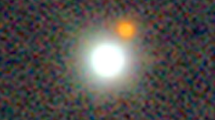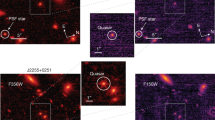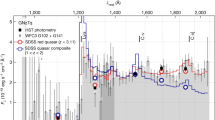Abstract
A quasar is thought to be powered by the infall of matter onto a supermassive black hole at the centre of a massive galaxy1,2. Because the optical luminosity of quasars exceeds that of their host galaxy, disentangling the two components can be difficult. This led in the 1990s to the controversial claim of the discovery of ‘naked’ quasars3,4,5,6,7. Since then, the connection between quasars and galaxies has been well established8. Here we report the discovery of a quasar lying at the edge of a gas cloud, whose size is comparable to that of a small galaxy, but whose spectrum shows no evidence for stars. The gas in the cloud is excited by the quasar itself. If a host galaxy is present, it is at least six times fainter than would normally be expected8,9 for such a bright quasar. The quasar is interacting dynamically with a neighbouring galaxy, whose gas might be feeding the black hole.
This is a preview of subscription content, access via your institution
Access options
Subscribe to this journal
Receive 51 print issues and online access
$199.00 per year
only $3.90 per issue
Buy this article
- Purchase on Springer Link
- Instant access to full article PDF
Prices may be subject to local taxes which are calculated during checkout





Similar content being viewed by others
References
Richstone, D. et al. Supermassive black holes and the evolution of galaxies. Nature 395, A14–A18 (1998)
Dunlop, J. S. et al. Quasars, their host galaxies and their central black holes. Mon. Not. R. Astron. Soc. 340, 1095–1135 (2003)
Bahcall, J. N., Kirhakos, S. & Schneider, D. P. HST images of nearby luminous quasars. Astrophys. J. 435, L11–L14 (1994)
Boyce, P. J., Disney, M. J. & Bleaken, D. G. Quasar host galaxy images from the Hubble Space Telescope archive. Mon. Not. R. Astron. Soc. 302, L39–L44 (1999)
Bahcall, J. N., Kirhakos, S., Saxe, D. H. & Schneider, D. P. Hubble Space Telescope images of a sample of 20 nearby luminous quasars. Astrophys. J. 479, 642–658 (1997)
Disney, M. J. et al. Interacting elliptical galaxies as hosts of intermediate redshift quasars. Nature 376, 150–153 (1995)
Hutchings, J. B. Quasars—hosts of possibilities. Nature 376, 118–119 (1995)
Floyd, D. J. E. et al. The host galaxies of luminous quasars. Mon. Not. R. Astron. Soc. 355, 196–220 (2004)
McLure, R. J. et al. A comparative HST imaging study of the host galaxies of radio-quiet quasars, radio-loud quasars and radio galaxies—I. Mon. Not. R. Astron. Soc. 308, 377–404 (1999)
de Grijp, M. H. K., Lub, J. & Miley, G. K. Warm IRAS sources. I. A catalogue of AGN candidates from the point source catalog. Astron. Astrophys. Suppl. 70, 95–114 (1987)
Low, F. J., Cutri, R. M., Huchra, J. P. & Kleinman, S. G. Infrared colour-selected quasars and Seyfert 1 galaxies. Astrophys. J. 327, L41–L45 (1988)
Boyce, P. J. et al. The host galaxies of IRAS-selected quasi-stellar objects. Astrophys. J. 473, 760–762 (1996)
Canalizo, G. & Stockton, A. Quasi-stellar objects, ultraluminous infrared galaxies, and mergers. Astrophys. J. 555, 719–743 (2001)
Magain, P., Courbin, F. & Sohy, S. Deconvolution with correct sampling. Astrophys. J. 494, 472–477 (1998)
Courbin, F., Magain, P., Kirkove, M. & Sohy, S. A method for spatial deconvolution of spectra. Astrophys. J. 529, 1136–1144 (2000)
Courbin, F. et al. On-axis spatially resolved spectroscopy of low redshift quasar host galaxies: HE 1503 + 0228, at z = 0.135. Astron. Astrophys. 394, 863–872 (2002)
Letawe, G. et al. On-axis spectroscopy of the z = 0.144 radio–loud quasar HE 1434–1600: an elliptical host with a highly ionized ISM. Astron. Astrophys. 424, 455–464 (2004)
Kaspi, S. et al. Reverberation measurements for 17 quasars and the size–mass–luminosity relations in active galactic nuclei. Astrophys. J. 533, 631–649 (2000)
McLure, R. J. & Dunlop, J. S. On the black hole–bulge mass relation in active and inactive galaxies. Mon. Not. R. Astron. Soc. 331, 795–804 (2002)
Bruzual, G. & Charlot, S. Stellar population synthesis at the resolution of 2003. Mon. Not. R. Astron. Soc. 344, 1000–1028 (2003)
Ferrarese, L. Beyond the bulge: A fundamental relation between supermassive black holes and dark matter halos. Astrophys. J. 578, 90–97 (2002)
Acknowledgements
P.J. is on leave from GEPI. This work has been supported by the PPS Science Policy (Belgium), by PRODEX (ESA), and by the Swiss National Science Fundation. The observations were obtained with the ESO/VLT (Paranal, Chile) and with the NASA/ESA Hubble Space Telescope.
Author information
Authors and Affiliations
Corresponding author
Ethics declarations
Competing interests
Reprints and permissions information is available at npg.nature.com/reprintsandpermissions. The authors declare no competing financial interests.
Rights and permissions
About this article
Cite this article
Magain, P., Letawe, G., Courbin, F. et al. Discovery of a bright quasar without a massive host galaxy. Nature 437, 381–384 (2005). https://doi.org/10.1038/nature04013
Received:
Accepted:
Issue Date:
DOI: https://doi.org/10.1038/nature04013
This article is cited by
-
Superquasars
Russian Physics Journal (2007)
Comments
By submitting a comment you agree to abide by our Terms and Community Guidelines. If you find something abusive or that does not comply with our terms or guidelines please flag it as inappropriate.



